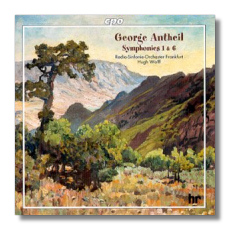
The Internet's Premier Classical Music Source
Related Links
- Antheil Reviews
- Latest Reviews
- More Reviews
-
By Composer
-
Collections
DVD & Blu-ray
Books
Concert Reviews
Articles/Interviews
Software
Audio
Search Amazon
Recommended Links
Site News
 CD Review
CD Review
George Antheil

Symphonies #1 & 6
- Symphony #1"Zingaresca"
- Symphony #6 "After Delacroix"
- Archipelago
Frankfurt Radio Symphony Orchestra/Hugh Wolff
CPO 999604-2 DDD 62:35
This is the second all-Antheil release in three months – very unusual! Is an Antheil renaissance afoot? (The other disc was from Naxos, and it included the composer's Fourth and Sixth Symphonies, plus the concert overture McConkey's Ferry.) George Carl Johann Antheil was born in 1900 to parents who owned a shoe store in New Jersey. He went to Paris and won notoriety in the 1920s for Ballet Mécanique, his score for Fernand Léger's Dadaist film. When Antheil returned to the United States, his career as a composer had its ups and downs, but mostly downs. He and his wife wrote a lonely-hearts column to keep themselves out of hock, and, with Hedy Lamarr, he invented a radio-controlled torpedo! He had some success in the United States around the time of World War Two and for few years after, but his career eventually deteriorated in he died in 1959.
Antheil's First Symphony was written in 1922. Leopold Stokowski took an interest in it, but the chance of a première with the Philadelphia Orchestra was lost when Antheil left for Europe. The Berlin Philharmonic Orchestra under the direction of Rudolf Schulz-Dornburg, then, gave the première. Although the musicians and the audience members were diverted by this strange new symphony, the critics disliked it. I can't explain the symphony's overall subtitle; I detect little about it that is gypsy-like. Also, the second and fourth movements are marked "Ragtime," and I hear little of that either. (The booklet notes mention Stravinsky's Pétrouchka instead, and I agree with the suggestion.) The symphony's construction has less to do with formal development than with the building block juxtaposition of contrasting materials. The opening movement is an almost impressionistic nature piece (inspired, at least in part, by New Jersey!), the second movement is a scherzo, the third seems to evoke "old sad tunes with heart-breaking memories" (Antheil's words), and the "Ragtime" finale continues the upbeat mood initiated in the second movement.
Pierre Monteux and the San Francisco Symphony premièred the Sixth Symphony in 1949. The symphony was inspired, at least in part, by Delacroix's painting of Liberty leading the people. It is in three movements, and it takes about 25 minutes to play. The first movement weaves fragments of the song "The Battle Cry of Freedom" into the orchestral fabric; it sounds like a collaboration between Prokofieff and Ives, but there are allusions (possibly unintentional) to the third movement of Shostakovich's Eighth Symphony too. The second movement is a nearly motionless waltz. Some have written that it is reminiscent of Satie. To me, the first section sounds like the slow movement from Shostakovich's Piano Concerto #1, while the middle section sounds like wartime Prokofieff writing about the nobility of man. The finale, which the composer intended as "the triumph of joy and optimism over despair, war, annihilation" has a jerky tune and a frenzied air in the style of Prokofieff. The noisy conclusion makes a virtue of bad taste.
Archipelago dates from 1935; it was premièred by the General Motors Symphony Orchestra! It's a five-minute rumba for orchestra, very "pop" and in the spirit of Gershwin's Cuban Overture. Antheil recycled it into his Second Symphony, where, with minor revisions, it became the third movement. The booklet notes hint that Wolff the Radio Symphony Frankfurt may get to that work in the future.
The Naxos disc is played by the National Symphony Orchestra of Ukraine under Theodore Kuchar. Wolff and the Frankfurt orchestra play with more refinement, and, in the finale of the Sixth Symphony, more spirit. However, Kuchar is better with the music's more introverted moments. Oddly, it is Wolff who brings out the symphony's tributes to Shostakovich and Prokofieff more strongly, whereas Kuchar is more Ivesian! There is disagreement over tempos too. Kuchar takes the first movement at 8:55 while Wolff is almost a minute faster at 7:58. In the middle movement, it is Wolff who is much slower: 10:30 to Kuchar's 9:09. Their finales differ by only 36 seconds. I'd get the Kuchar first because it is so inexpensive, but if you like it – and I think you will – the Wolff is your next logical purchase. More Antheil, please.
Copyright © 2000, Raymond Tuttle



















